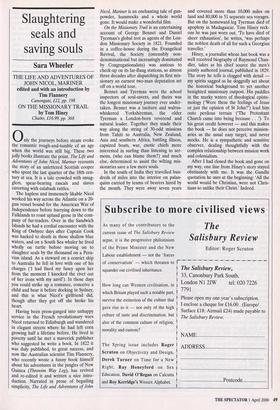Slaughtering seals and saving souls
Sara Wheeler
THE LIFE AND ADVENTURES OF JOHN NICOL, MARINER edited and with an introduction by Tim Flannery Canongate, £12, pp. 198 ON THE MISSIONARY TRAIL by Tom Hiney Chatto, £16.99, pp. 368 Only the journeys before steam evoke the romantic rough-and-tumble of an age when the world was still big. These two jolly books illustrate the point. The Life and Adventures of John Nicol, Mariner recounts the story of an unlettered Scottish cooper who spent the last quarter of the 18th cen- tury at sea. It is a tale crowded with smug- glers, spear-bearing rascals and slaves cavorting with calabash rattles.
The hapless and immensely likable Nicol worked his way across the Atlantic on a 20- gun vessel bound for the American War of Independence before hurrying down to the Falklands to roast upland geese in the com- pany of fur-traders. Over in the Sandwich Islands he had a cordial encounter with the King of Owhyee days after Captain Cook was hacked to death in those shallow blue waters, and on a South Sea whaler he lived wholly on turtle before moving on to slaughter seals by the thousand on a Peru- vian island. As a steward on a convict ship to Australia he fell in love with one of his charges CI had fixed my fancy upon her from the moment I knocked the rivet out of her irons with my anvil'). In those days you could strike up a romance, conceive a child and bear it before docking in Sydney, and this is what Nicol's girlfriend did, though after they got off she broke his heart.
Having been press-ganged into unhappy service in the French revolutionary wars Nicol returned to Edinburgh and wandered in elegant streets where he had left corn growing half a lifetime before. He lived in poverty until he met a maverick publisher who suggested he write a book. In 1822 it was duly published, to great success, and now the Australian scientist Tim Flannery, who recently wrote a funny book himself about his adventures in the jungles of New Guinea (Throwim Way Leg), has revived and re-edited it and written a nice intro- duction. Narrated in prose of beguiling simplicity, The Life and Adventures of John Nicol, Mariner is an enchanting tale of gun- powder, hammocks and a whole world gone. It would make a wonderful film.
On the Missionary Trail is an entertaining account of George Bennet and Daniel Tyerman's global trot as agents of the Lon- don Missionary Society in 1821. Founded in a coffee-house during the Evangelical Revival, the Society (ostensibly non- denominational but increasingly dominated by Congregationalists) was anxious to check-up on its far-flung stations, so almost three decades after dispatching its first mis- sionary an earnest two-man deputation set off on a world tour.
Bennet and Tyerman were the school inspectors of soul-savers, and theirs was the longest missionary journey ever under- taken. Bennet was a taciturn and walrus- whiskered Yorkshireman, the older Tyerman a London-born reverend and natural leader. Together they made their way along the string of 30-odd missions from Tahiti to Australia, New Zealand, Asia and southern Africa, battling illness, capsized boats, war, exotic chiefs more interested in surfing than listening to ser- mons, (who can blame them?) and much else, determined to assist the wilting mis- sionaries save a few more souls.
In the south of India they travelled hun- dreds of miles into the interior on palan- quins carried by teams of bearers hired by the month. They were away seven years and covered more than 10,000 miles on land and 80,000 in 51 separate sea voyages. But on the homeward leg Tyerman died of apoplexy in Madagascar. Tom Hiney reck- ons he was just worn out. 'To have died of sheer exhaustion', he writes, 'was perhaps the noblest death of all for such a Georgian traveller.'
Hiney, a journalist whose last book was a well received biography of Raymond Chan- dler, takes as his chief source the men's jointly authored journal, published in 1829. The story he tells is clogged with detail my spirits sagged as he doggedly set about the historical background to yet another benighted missionary outpost. His paddles in the murky waters of theological episte- mology (`Were these the feelings of Jesus or just the opinion of St John?') lead him onto perilous terrain (`The Protestant Church came into being because . . .'). To his great credit however — and this makes the book — he does not perceive mission- aries as the usual easy target, and never mocks. He is a sympathetic and sensitive observer, dealing thoughtfully with the complex relationship between mission work and colonialism.
After I had closed the book and gone on my way, one line from Hiney's story stayed obstinately with me. It was the Gandhi quotation he uses at the beginning: 'All the world would be Christian, were not Chris- tians so unlike their Christ.' Indeed.






















































































 Previous page
Previous page